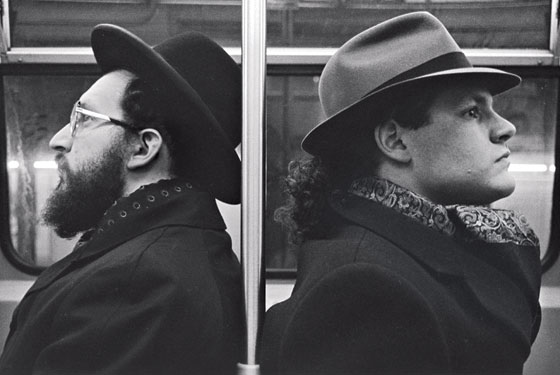 |
(Photo: Richard Sandler) |
A New York Jew is a kind of universally acknowledged wizard, like a Swiss banker, an English tailor, or a Parisian couturier. Fast-talking, funny, obnoxious, able to conjure some shimmering, tantalizing brilliance on the fly while complaining about the stale Danish and bad coffee and waving a folded copy of the New York Times at the oncoming traffic, with one foot planted firmly on the cracked sidewalk and the other tapping on the curb.
Everyone who comes to New York City in 2008 becomes a little bit Jewish by osmosis. New Yorkers eat Thai food, buy condoms in Korean delis, and face death at the hands of insanely reckless Nigerian cabdrivers, but they inhabit a moral universe in which certainty and doubt are balanced according to a particular mathematics that is intimately familiar to Jews and not quite so familiar to other tribes. The glass towers of midtown Manhattan are filled with Jewish magicians who manipulate abstract symbols that shape the contents of people’s characters and opinions as well as the contents of their wallets and can seemingly be transformed at will into other markers of value in a dizzying progression that destroys the certainties of blood and soil on which life is founded for ordinary villagers. Ivy League graduates who move to New York often find themselves thinking about how their Jewish friends, co-workers, and bosses are different from their neighbors back home—less polite, more exciting, more exacting and didactic, with different ideas about pleasure and sin.
Future historians will record that the Jews replaced the old Protestant elite, who had run the city off and on since the eighteenth century until their power was finally shattered by the cultural metamorphosis of 1968, followed by the financial collapse of 1974. John Lindsay, New York’s last Wasp mayor, presided over a city falling into bankruptcy and seemingly irreconcilable racial and class tensions. Academics and residents agreed that New York City was dead—a mid-century idea on which the clock had finally run out. Lindsay’s successor, Abe Beame, was the first Jewish mayor of a city where Jews would assume the leading positions of political, economic, and cultural power.
It takes a certain amount of effort to remember that it was not surprising even into the late sixties for Jews to be excluded from top-tier jobs at the commercial banks, ad agencies, and insurance companies that formed the elite of the city’s business class, and from the boards of the city’s major charities and cultural institutions. Jews were barred from membership in midtown social clubs, from golf courses and tennis clubs, and from buying apartments in desirable buildings on Park Avenue. Universities like Harvard, Princeton, and Yale did their best not to employ Jews on their faculty and made “character” (by which they meant a lack of Jewishness) a criterion for admission. The Jews of New York City had their own banks, their own law firms, their own social clubs, and their own charities, which enabled them to function as a kind of parallel elite, making their exclusion from the apex of social, cultural, and political power all the more glaring. Today, it is hard to think of a single institution in the city that doesn’t open its doors wide to Jews (and not just a few token Jews, or the “right kind” of Jews)—Citibank, the board of the New York Philharmonic, the New York Times (a newspaper owned by Jews-turned-Episcopalians whose first Jewish editor, A. M. Rosenthal, was appointed in 1969), The New Yorker (once the home of Cheever-style gentility, now edited by a Jew who writes regularly about Philip Roth, the State of Israel, and other family business), the Metropolitan Club, the Century Club, whatever. Who would want to belong to a club in New York that didn’t accept Jews as members? What on earth would you do there?
The Jews owe a debt to David Rockefeller, who eased their path onto the boards of prominent cultural institutions like MoMA and helped create a new finance-based economy for the city that rewarded the Jewish talent for abstraction, and to Edward Koch, who fused the familiar voice of the Jewish underdog with a policy of large tax breaks for the kinds of businesses that would become the foundation of the city’s future. Without these two men, New York might have gone the goyish way of Baltimore or Philadelphia, the kind of place that no one in his right mind would want to visit even for the funeral of his enemies.
The ascendancy of the Jews of New York can be viewed as a Hollywood-style triumph, but it can also be read as the tragedy of a group of brilliant outsiders who remade a city in their own image, only to cut themselves off from the roots of their tribal genius, ensuring that the future will belong to the children of the new outsiders—Koreans, Indians, Russians, and Chinese.

